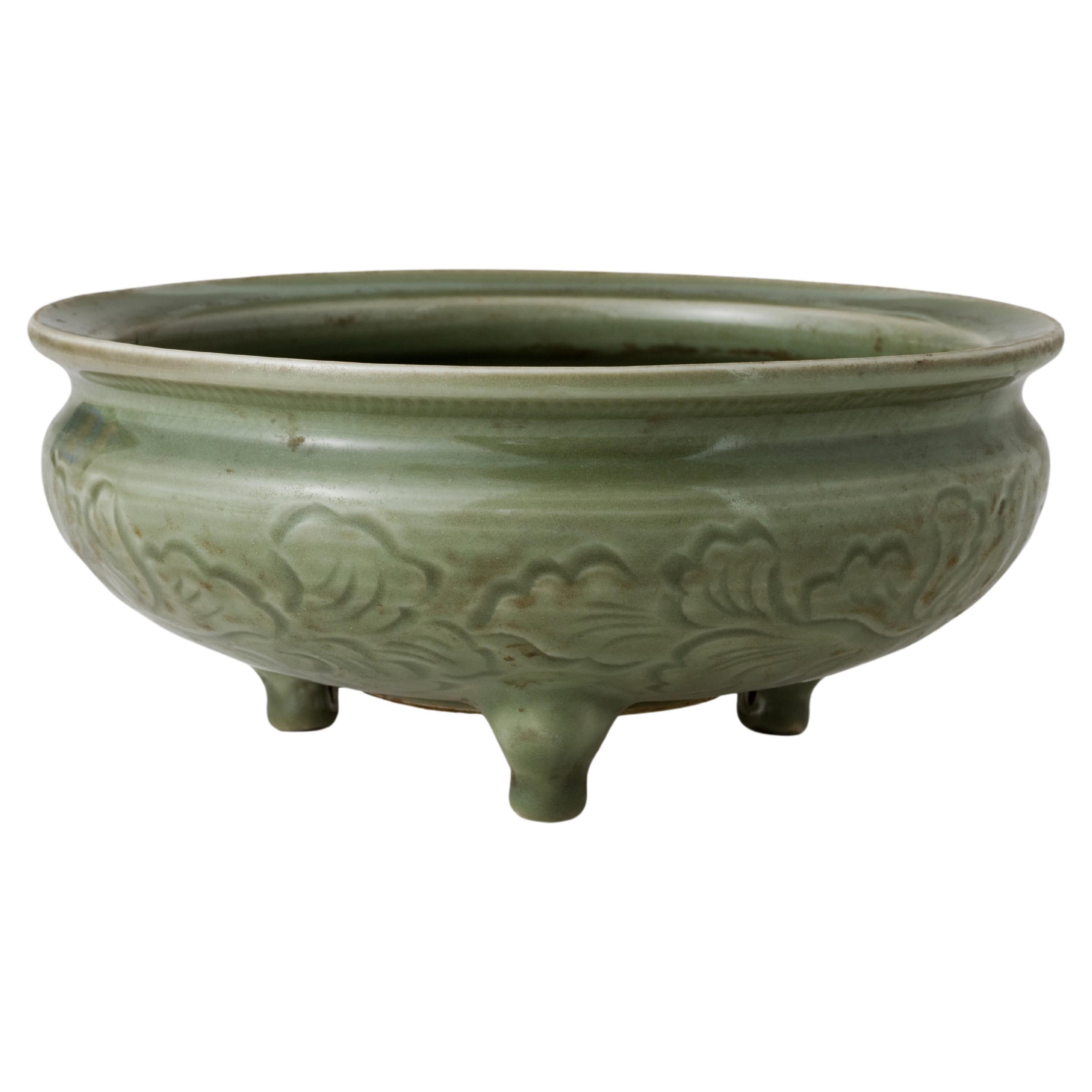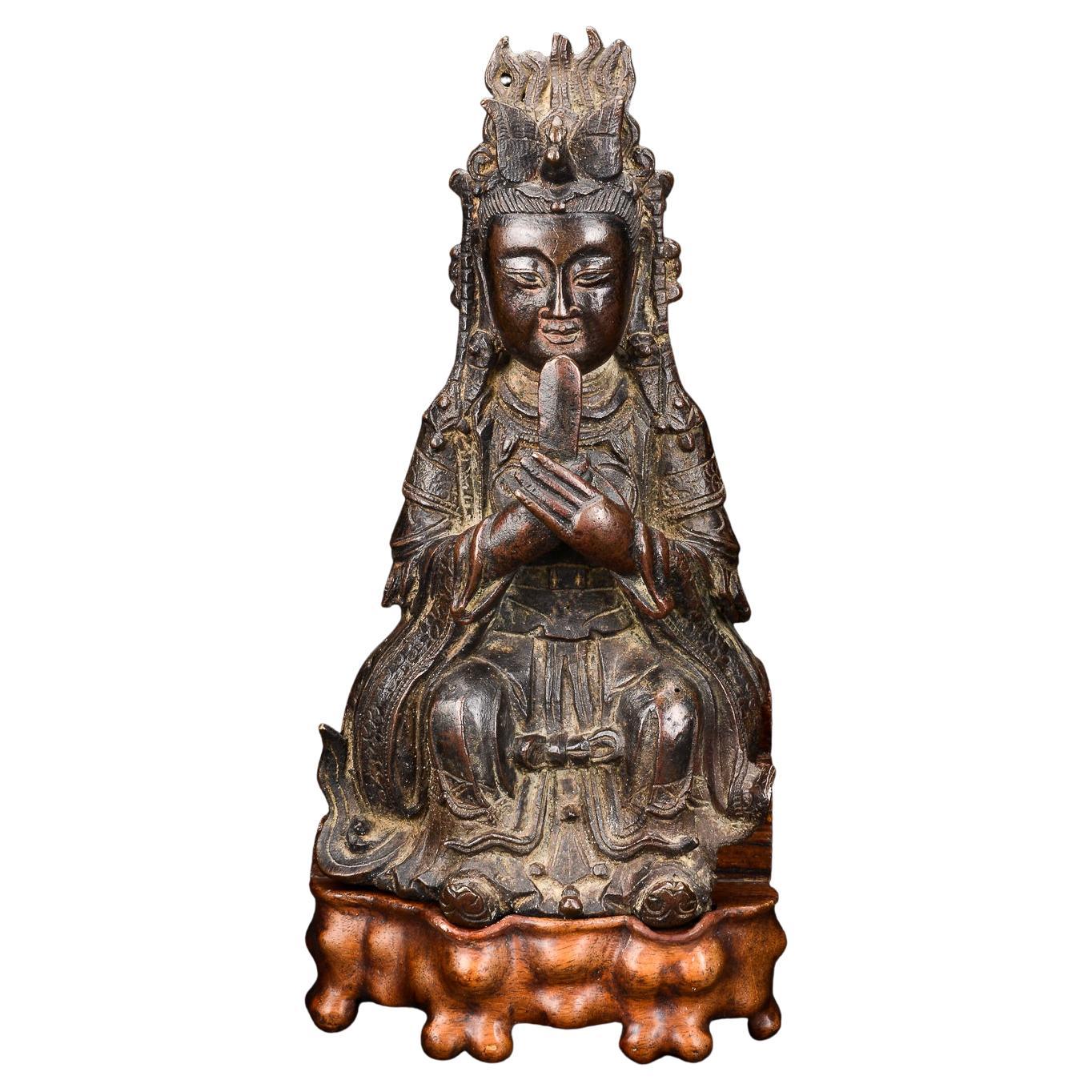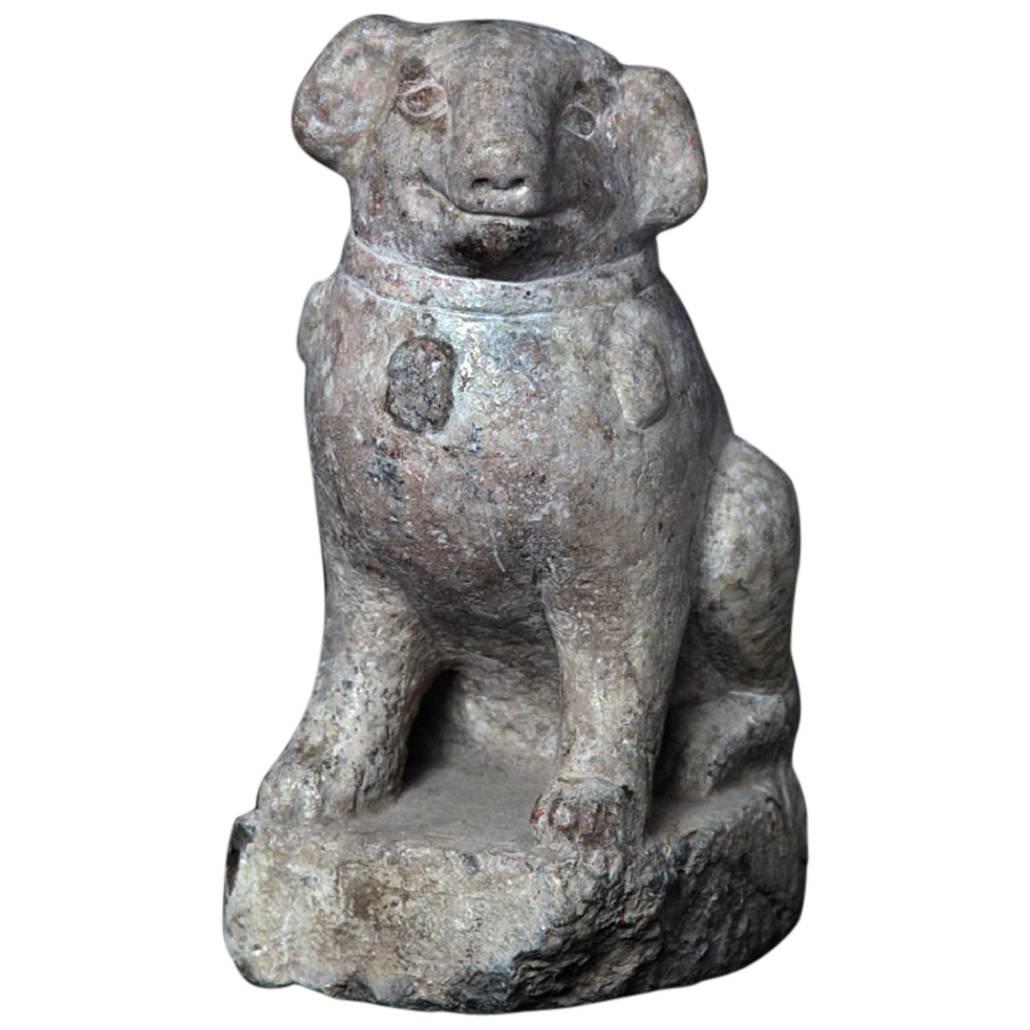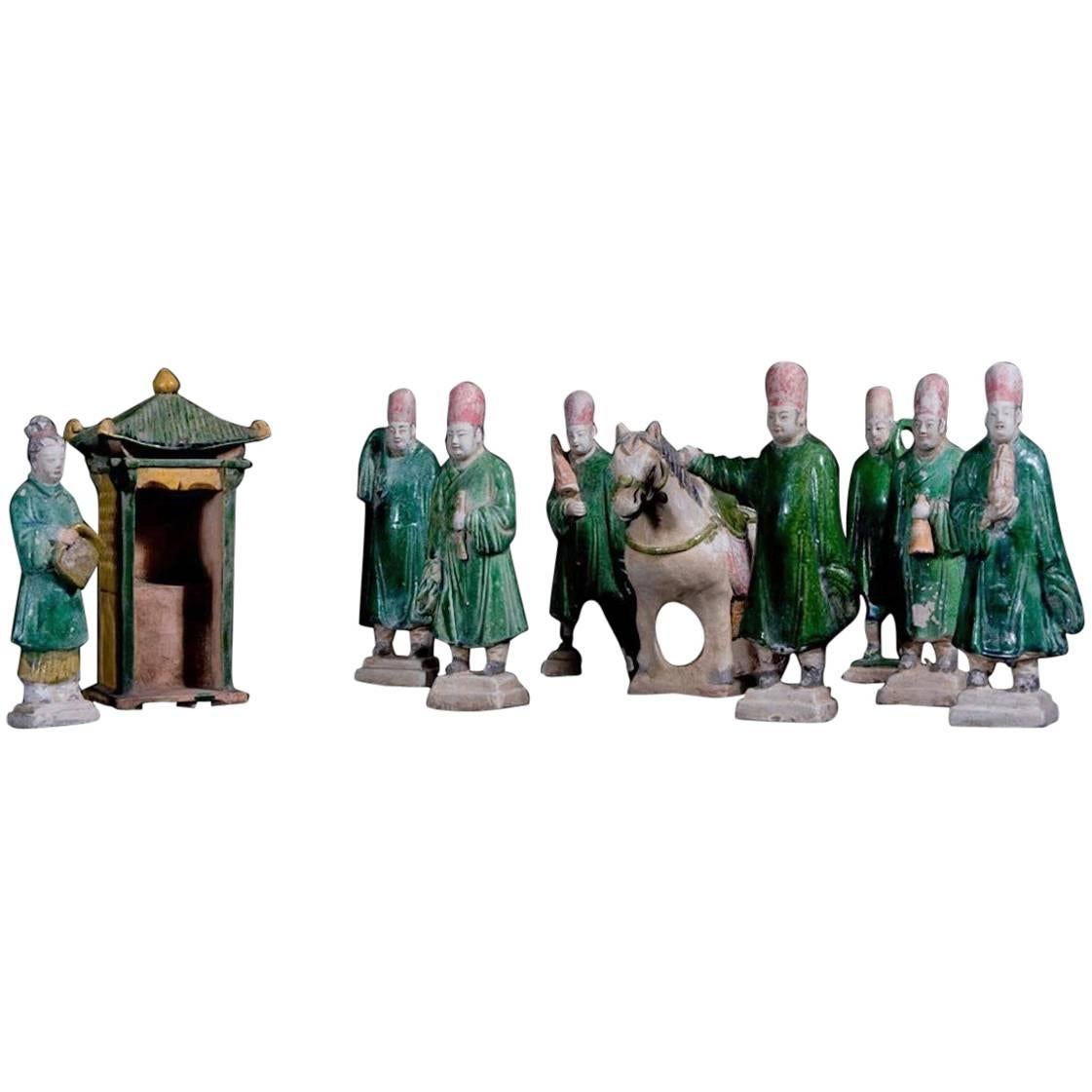Items Similar to Longquan Celadon Figurine, Ming Dynasty (1368-1644)
Want more images or videos?
Request additional images or videos from the seller
1 of 11
Longquan Celadon Figurine, Ming Dynasty (1368-1644)
About the Item
This sculpture is a Longquan celadon from the Ming Dynasty, renowned for its rich and jade-like green glaze. The figurine is likely a representation of a Buddhist deity or a revered scholar, showcasing the calm aesthetic expressions and graceful contours prevalent during the era. The spectrum of celadon glaze ranges from a dense grey stoneware to a nearly white porcelain texture, with unglazed parts revealing a terracotta brown upon firing. Such pieces were often part of household altars, reflecting the era's spiritual devotion. This artifact would be a treasured exhibit in any museum's Asian art collection, symbolizing both religious reverence and artistic excellence.
Period: Ming Dynasty (1368-1644)
Region: Longquan, China
Medium: Stoneware - Celadon glazed, with a range from heavy grey to almost white porcelain-like material
Type: Sculpture
Height : 24.5 cm
Provenance : Acquired in 1999, Hongkong
* Ming Dynasty Longquan Celadon
Longquan celadon from the Ming Dynasty typically exhibits a more robust and heavier stoneware body compared to its Song Dynasty predecessors. The Ming era saw an evolution in celadon glaze, achieving a wider spectrum of green hues, from olive to bluish-greens. Ming celadons often had thicker glaze applications, sometimes featuring multiple layers and even multiple firings to attain depth and richness in the glaze.
In contrast, Song Dynasty Longquan celadons are known for their more refined and thinner bodies, with a glaze palette that tends toward more subtle and more uniform green shades. The shapes of Song celadons were usually simpler, emphasizing the glaze's quality and texture.
During the Song period, there was also a greater emphasis on subtle and elegant forms, with less ornate decoration compared to the Ming pieces, which showcased more elaborate decorative motifs, including incised or moulded patterns. Song Dynasty Longquan wares were also highly prized for their thin walls and lightness, reflecting a high level of technical mastery in pottery-making.
Overall, while both dynasties produced celadons of exceptional quality, the Ming Longquan celadons are distinguished by their bolder forms and more varied glaze effects, while the Song Dynasty celadons are celebrated for their simplicity and the pure beauty of their glazes.
About the Seller
New to 1stDibs
Joined in the past six months.
4.5
Vetted Seller
These experienced sellers undergo a comprehensive evaluation by our team of in-house experts.
Established in 1999
1stDibs seller since 2023
Typical response time: 1 hour
- ShippingRetrieving quote...Ships From: seoul, Korea South
- Return PolicyA return for this item may be initiated within 10 days of delivery.
More From This SellerView All
- Carved 'Longquan' Celadon-Glazed Tripod Censer, Ming dynastyLocated in seoul, KRThis censer is characterized by its tripod form, which means it stands on three feet. Incense burners from the Ming dynasty are often highly regarded for their craftsmanship and the quality of the glaze texture and coloration. This piece features finely carved patterns that likely draw inspiration from traditional Chinese motifs. Such items were commonly used for burning incense and sometimes served as significant decorative pieces in ceremonial spaces or the homes of the elite. Period: Ming Dynasty (1368~1644) Region: Longquan, China Medium: Stoneware - Celadon glazed Type: Tripod censer Size : 24.2 cm(Diameter) , 10.8cm(Height) Provenance : Acquired in 1999, Hongkong Reference : Sotheby's Newyork 26 September 2023 - CHINA / 5000 YEARS - Lot1135 * Ming Dynasty Longquan Celadon Longquan celadon from the Ming Dynasty typically exhibits a more robust and heavier stoneware body compared to its Song Dynasty predecessors. The Ming era saw an evolution in celadon glaze, achieving a wider spectrum of green hues, from olive to bluish-greens. Ming celadons...Category
Antique 15th Century and Earlier Chinese Ming Antiquities
MaterialsCeladon
- A Longquan Celadon-Glazed 'Dragon' Dish, Yuan DynastyLocated in seoul, KRThe dish is decorated to the centre with a moulded appliqué dragon chasing the flaming pearl surrounded by a carved stylised foliage band at the cavetto. The moulded fluted exterior ...Category
Antique 15th Century and Earlier Chinese Ming Antiquities
MaterialsCeladon
- Longquan Celadon 'Dragon' Jar and Cover, Southern Song Dynasty(1127–1279)Located in seoul, KRA similar jar with a cover, part of the Avery Brundage collection at the Asian Art Museum in San Francisco, is featured in Mary Tregear's "Song Ceramics" (London, 1982, plate 286). T...Category
Antique 15th Century and Earlier Chinese Ming Antiquities
MaterialsCeladon
- Longquan Celadon Five-Spouted Jar, Northern Song Dynasty (AD 960~1127)Located in seoul, KRThickly potted with an ovoid body of five horizontal lobes tapering toward the top, carries both aesthetic and practical values. The jar is intricately carved with rows of upright lo...Category
Antique 15th Century and Earlier Chinese Ming Antiquities
MaterialsCeladon
- Carved 'Yaozhou' Celadon-Glazed Bowl, Song DynastyLocated in seoul, KRThe bowl is potted with steep, flared sides and decorated to the interior with stylized peonies among scrolling tendrils. The exterior is carved with vertical lines below the everted...Category
Antique 15th Century and Earlier Chinese Ming Antiquities
MaterialsCeladon
- Moulded Goldfish Blue and White Dishes, Ming DynastyLocated in seoul, KRExquisitely decorated set of plates, dating back to around 1500, from the Hongzhi or Zhengde period. Intricately adorned with a raised, moulded goldfish design. The goldfish, painted in a orange-red enamel, are set amidst water plants depicted in rich cobalt blue. These plates enjoyed widespread popularity, not only in the local markets of China but also overseas in countries. This style of plate played a significant role in the daily life of the Sengoku period in Japan, as evidenced by several similar flat bowls excavated from the Ichijodani Asakura Ruins in Fukui Prefecture, Japan, along with other ceramic artifacts...Category
Antique 16th Century Chinese Ming Antiquities
MaterialsCeramic
You May Also Like
- Bixia Yuanjun Figure of Bronze Dated Ming Dynasty, 1368-1644Located in London, GBBixia Yuanjun figure of bronze dated Ming Dynasty 1368-1644. Base of hardwood. Height excluding base 26cm; Heigh including base 31cm. Condition: Corrosion on reverse/back; ...Category
Antique 15th Century and Earlier Chinese Ming Antiquities
MaterialsBronze
- Important Ancient Chinese Effigy Pug Dog, Ming Dynasty 1368-1644Located in South Burlington, VTChina, a carving of a canine “Pug”, Ming Dynasty, 1368-1644 CE Dimensions: 38 cm, 15” High Photographs taken indoors and out of doors for your viewing pleasure. The hand carved limestone beast shown on its haunches with naturalistic joyful expression and a well defined compact head, ears, noes, eyes, feet, and tail parted to one side on reverse with distinctive collar ornament seated four square on a thick base all-over showing a weathered surface from significant age. Formerly exhibited “Asia Week” New York City, Fuller Building, Hutton Gallery 2006. Provenance: ex collection luoyang, Henan Province, China. Includes custom display base as shown Catalog reference: 35 years collecting 35 treasures, Number 35, p.76 (photo) In ancient China, it is a well-known fact that several types of small dogs were bred and were favored pet gifts between emperors and kings including Lion Dogs, Pekingese and Lo-sze breeds. Some Lo-sze are pictured wearing collars with bells a frequent combination fancied by European royalty of the seventeenth and eighteenth centuries. Lo-sze or pugs were prized for their compact body, good bones, flat face, square jaw, short coat, curled tail, side set back ears, and temperate disposition. History: Placing stone animals in important tombs can be traced back at least to the Qin Dynasty (221-206 BCE), some two thousand years ago. In ancient times, stone animals and human figures placed before imperial tombs symbolized royal power and privilege in addition to decorative functions. The first Ming tomb...Category
Antique 15th Century and Earlier Chinese Ming Sculptures and Carvings
MaterialsLimestone
- Impressive Terracotta Funerary Procession - Ming Dynasty, China '1368-1644 AD'Located in San Pedro Garza Garcia, Nuevo LeonImpressive Funeral Ensamble of 10 Terracotta Glazed Figures in green and caramel colors depicting a votive procession with a palanquin, his four carriers, a horse, a stableman, two musicians, and an offering carrier. This ensemble is accompanied by a Certificate of Authenticity, and Certificate of Expertise by Jean-Yves Nathan - Specialist in Asian Arts for the CEDEA (The European Confederation of Art Experts). Burial figurines of graceful dancers, mystical beasts, and everyday objects reveal both how people in early China approached death and how they lived. Since people viewed the afterlife as an extension of worldly life, these figurines, called mingqi, sometimes referred as “spirit utensils” or “vessels of ghosts” disclose details of routine existence and provide insights into belief systems over a thousand-year period. The Ming dynasty was the ruling dynasty of China – then known as the Empire of the Great Ming – for 276 years (1368–1644 AD). Founded by Chu Yuan-chang, the rebel leader that was successful in removing the mongols from the throne. Chinese control was re-asserted in China and eastern Asia. Literature became more important, schools were created, and the justice system was reformed. The Ming dynasty is described by some as "one of the greatest eras of orderly government and social stability in human history,” was the last imperial dynasty in China ruled by ethnic Han Chinese. The practice of burying ceramic objects with the deceased went into decline from the 10th to the 14th Century AD. There was a revival in placing miniature representations of glazed terracotta objects such a furniture, food offerings, horses, miniature statues...Category
Antique 15th Century and Earlier Chinese Ming Antiquities
MaterialsTerracotta
- 6 Elegant Ming Dynasty Court Attendants in Glazed Terracotta, China 1368-1644 ADLocated in San Pedro Garza Garcia, Nuevo LeonA fine set of a six court attendants as in the Forbidden City of Beijing, elegantly dressed in a Green & Red Daopao – a traditional men’s formal attire from the Ming Dynasty dated 1368-1643 A.D. – with glazed robes and Red Pigment remains in their hat and belts. They stand in an honorary posture atop a red plinth, some with orifices in their hands, where spirit objects were placed to comfort or satisfy the deceased. The heads are detachable, as often seen on the larger figures from this period. They are accompanied by a Certificate of Authenticity, and Certificate of Expertise by Jean-Yves Nathan - a leading authority specialized in Far East Archaeology from the CEDEA (The European Confederation of Art Experts). Burial figurines of graceful dancers, mystical beasts, and everyday objects reveal both how people in early China approached death and how they lived. Since people viewed the afterlife as an extension of worldly life, these figurines, called mingqi, sometimes referred as “spirit utensils” or “vessels of ghosts” disclose details of routine existence and provide insights into belief systems over a thousand-year period. The Ming dynasty was the ruling dynasty of China – then known as the Empire of the Great Ming – for 276 years (1368–1644 AD). Founded by Chu Yuan-chang, the rebel leader that was successful in removing the mongols from the throne. Chinese control was re-asserted in China and eastern Asia. Literature became more important, schools were created, and the justice system was reformed. The Ming dynasty is described by some as "one of the greatest eras of orderly government and social stability in human history,” was the last imperial dynasty in China ruled by ethnic Han Chinese. The practice of burying ceramic objects with the deceased went into decline from the 10th to the 14th Century AD. There was a revival in placing miniature representations of glazed terracotta objects such a furniture, food offerings, horses, miniature statues...Category
Antique 15th Century and Earlier Chinese Ming Antiquities
MaterialsTerracotta
- Magnificent Court Attendants in Terracotta - Ming Dynasty, China 1368-1644 AD TLLocated in San Pedro Garza Garcia, Nuevo LeonA magnificent pair of male and female courtiers from the Ming Dynasty (1368-1644 CE) in excellent condition. They are wearing traditional Daopao robes in green and black garments wit...Category
Antique 15th Century and Earlier Chinese Ming Antiquities
MaterialsTerracotta
- Ming Dynasty Celestial Deity Head Carved in Stone - China '1368-1644 AD'Located in San Pedro Garza Garcia, Nuevo LeonWonderful celestial deity head with a jovial expression in stone with a finely engraved cap. It is mounted on a custom lucite base. This piece is accompanied by a Certificate of Authenticity, and Certificate of Expertise by Jean-Yves Nathan - Specialist in Asian Arts for the CEDEA (The European Confederation of Art Experts). The Ming dynasty was the ruling dynasty of China – then known as the Empire of the Great Ming...Category
Antique 15th Century and Earlier Chinese Ming Antiquities
MaterialsStone
Recently Viewed
View AllMore Ways To Browse
Chinese Han Dog
Black Chairs Living Room
20th Century Desk
Antique Vintage Mid
Bar Table Living Room
Carpet Of Gold
Carts And Trolleys
Mid Century Modern Coffee Table Base
Georgian Study
1947 Poster
1937 Poster
Furniture From 1935
German Glass Vase
Taupe Blue Rug
Collection Of French Mirrors
Bar Table Bar Set And Table
Pair Of White Wall Lights
Germany 60s





